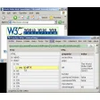Analyze online content and check out the code used
Analyze online content and check out the code used
Vote: (3 votes)
Program license: Trial version
Developer: Sembel
Version: 2.1.7
Works under: Windows
Vote:
Program license
(3 votes)
Trial version
Developer
Version
Sembel
2.1.7
Works under:
Windows
Pros
- Detailed information for HTML, DHTML, CSS, and Forms
- Facilitates easy cookie management and testing
- Conveniently integrated into Internet Explorer’s context menu
- Provides valuable insights for novice to intermediate developers
- Lightweight and does not heavily tax system resources
Cons
- Exclusively available for Internet Explorer
- Not suited for more casual web users
- Lacks cross-browser compatibility evaluation features
Comprehensive Analysis Tool for Web Developers
PageSpy is an intricate add-on designed for Internet Explorer that serves as a powerful tool for web developers, particularly those in the early stages of their career or practitioners looking to deepen their understanding of web technologies. This utility facilitates the examination and deconstruction of web page elements and the underlying code, which can provide a clearer understanding of how web interfaces are constructed and function.
Target Audience and Utility
PageSpy seems particularly tailored for novice and intermediate web developers who are keen to decode the mysteries of website construction and front-end coding. It’s not only a valuable educational resource for those honing their development skills but also a diagnostic tool for more experienced developers seeking to troubleshoot specific elements on a web page.
Features and Functionality
The plug-in provides an insightful peek into various aspects of web design and development. Upon selecting an element and right-clicking, users can access a context menu that unveils extensive details about the coding involved.
Detailed Analytics: It offers a range of analytically focused tabs, including 'Source' for viewing the page's source code, and 'DHTML' to examine the dynamic HTML generated post server-side script processing.
Cookie Inspection: Tracking and management of cookies become simplified, allowing developers to monitor which cookies are associated with the page and even insert their own for testing purposes.
Forms and CSS Insights: Two critical aspects of web development, 'Forms,' and 'CSS,' are laid out comprehensively, presenting both the structure and source code in an easy-to-understand format. This feature can be particularly enlightening for those learning about user input handling and styling.
Element Properties: The 'This' tab opens up a wealth of information regarding the selected web element's properties and attributes, many of which may return a "Null" value, indicating their inapplicability but confirming their assessment.
Performance and Accessibility
PageSpy impresses with its capabilities despite being remarkably lightweight and unobtrusive. It seamlessly integrates with Internet Explorer, providing convenience and a substantial cache of information without substantial load times or system overhead.
However, its exclusivity to Internet Explorer may limit its accessibility for those who utilize alternative browsers such as Firefox or Chrome. The modern web development landscape often requires cross-browser compatibility checks, and a tool that operates on just one browser could be considered a limitation in this context.
Conclusions
PageSpy is a commendable tool for individuals looking to expand their web development skills or for seasoned professionals requiring a detailed breakdown of page components. While its singular browser support narrows its audience, the depth of insight and ease-of-use make it a worthy addition to any Internet Explorer user’s repertoire.
Pros
- Detailed information for HTML, DHTML, CSS, and Forms
- Facilitates easy cookie management and testing
- Conveniently integrated into Internet Explorer’s context menu
- Provides valuable insights for novice to intermediate developers
- Lightweight and does not heavily tax system resources
Cons
- Exclusively available for Internet Explorer
- Not suited for more casual web users
- Lacks cross-browser compatibility evaluation features



